Adventurous Kate contains affiliate links. If you make a purchase through these links, I will earn a commission at no extra cost to you. Thanks!
When’s the best time to visit Croatia? You deserve a fantastic trip to Croatia — and that includes timing your trip perfectly! Croatia is one of the most beautiful bucket list destinations in all of Europe.
Croatia is one of my all-time favorite countries, and I’ve spent months traveling the country extensively. Not every time of year in Croatia is the same, and you’ll have a lot more fun in September than January.
Most people travel to Croatia in the summer months — and for good reason. Croatia has arguably the most beautiful coastline on the planet, with roads curving around mountains, tiny white stone villages topped with orange roofs, and hidden pebble beaches leading to bright teal water. Summer in Croatia is like turning the volume up to 11.
But summer isn’t the only option in Croatia. For certain kinds of travelers, the shoulder season might be even better for you than summer.
You can have fun in Croatia year-round! Even in January! But a lot of what makes Croatia wonderful — swimming in the Adriatic, hiking through national parks, dancing at music festivals — is very seasonally dependent.
Read on for the best time of year to visit Croatia!
Table of Contents
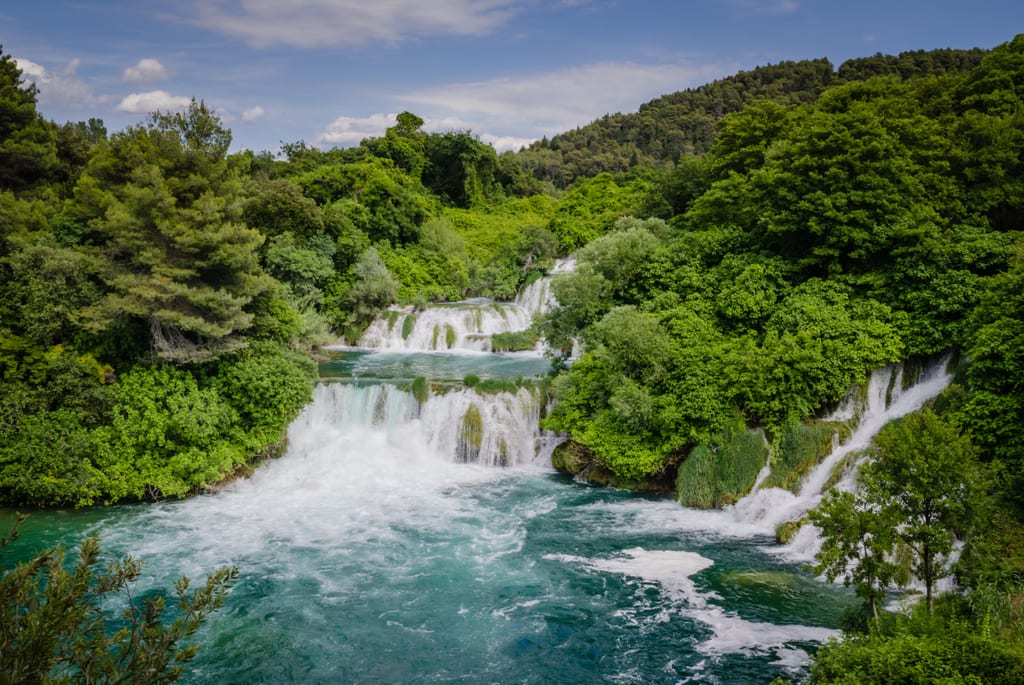
Best Time to Visit Croatia
Most travelers come to Croatia during the summer months to enjoy the beaches and islands. And while peak summer can be a bit too busy, you can enjoy yourself in the shoulder season as well.
Most people visit Croatia during the summer months, from June through September, so they can enjoy the beaches, islands, and warm days with very little rain.
In my opinion, September is the best month to visit Croatia, ideally late September. You get summer weather, fewer crowds, and the water is much warmer than in June.
You can visit Croatia year-round with kids. The summer months are your best options for a beach holiday, but spring and fall are excellent times for exploring Croatia’s culture.
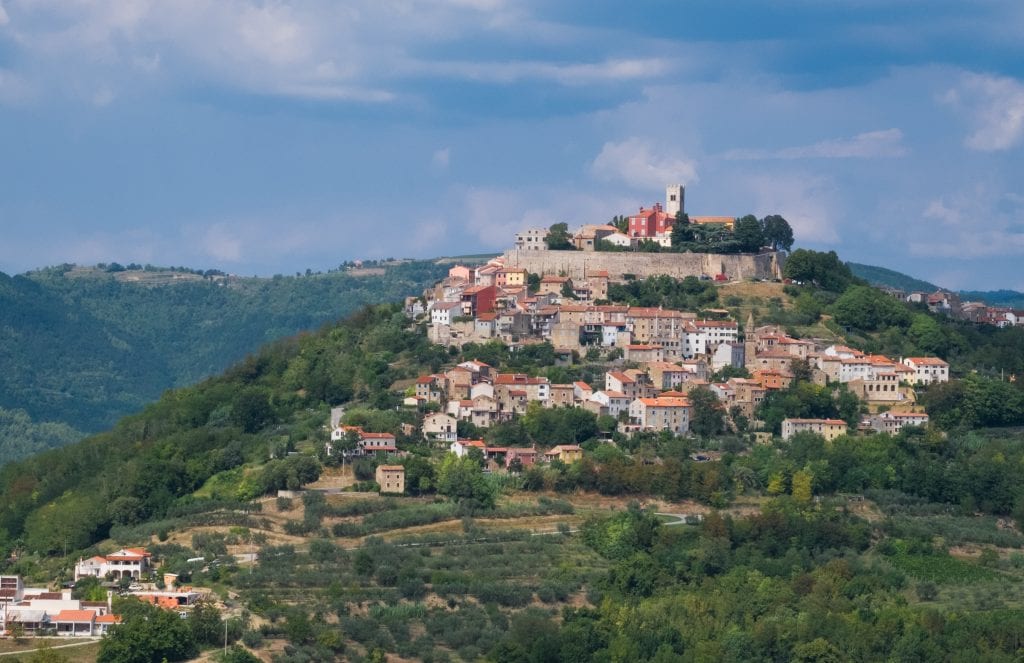
Croatia Weather
Croatia has an Adriatic climate, generally speaking, which is not surprisingly quite like a Mediterranean climate. Even so, the country doesn’t have one universal climate. There is a lot of variation within the country when it comes to weather.
Most Croatia travelers come to visit the Dalmatian coast in southern Croatia — including places like Dubrovnik, Hvar, and Split. This is the warmest and sunniest part of Croatia with a long summer season that runs from late May to early October.
Istria, the Italian-flavored peninsula in Croatia’s northwest, isn’t quite as sunny or as warm as Dalmatia, but you still have hot summers with slightly cooler springs and falls and a shorter summer season overall.
Zagreb is further inland and it can get both quite hot and quite cold here — and it snows most winters. Shoulder season is when Zagreb is at its best.
Slavonia, the off-the-beaten-path region in the far northeast, has more extreme temperatures than the rest of the country. Expect stiflingly hot summers and bitterly cold winters.
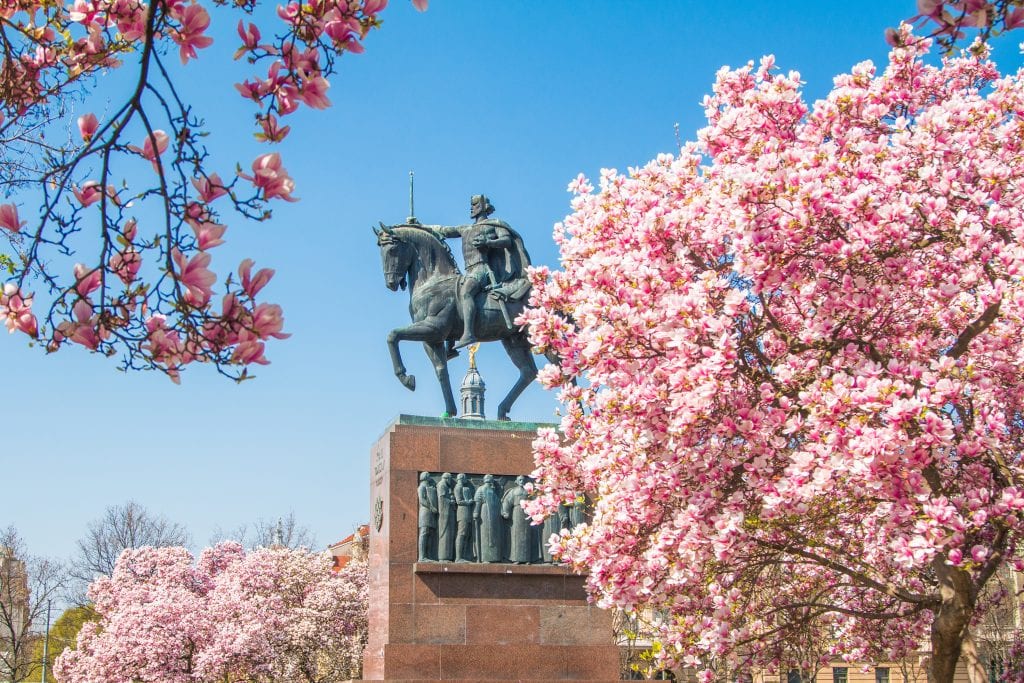
Spring in Croatia
Spring is when Croatia bursts into bloom. The weather starts to warm in early March in Dalmatia and later March in regions further north like Istria and Zagreb. Flowers dot the landscape in April and continue into May, making it a beautiful time to visit Croatia.
Croatia is a deeply religious country and Easter is the major holiday of the spring. Many Croatians take Easter week as a mini-holiday to enjoy the coast before the tourists arrive. Spring is also a popular time for cultural festivals.
Spring can be a particularly nice to visit the Plitvice Lakes and Krka National Park, as the waterfalls are extra flush with snowmelt.
Spring in Croatia lasts until late May. By that point, Jadrolinija (Croatia’s ferry line) starts up its summer schedule and people will be sunning on the beach in Dalmatia. The heat slowly creeps northward.
Overall, spring can be a lovely time to experience a beautiful and warm Croatia without the tourist crowds — but I would recommend visiting in April or May rather than March.
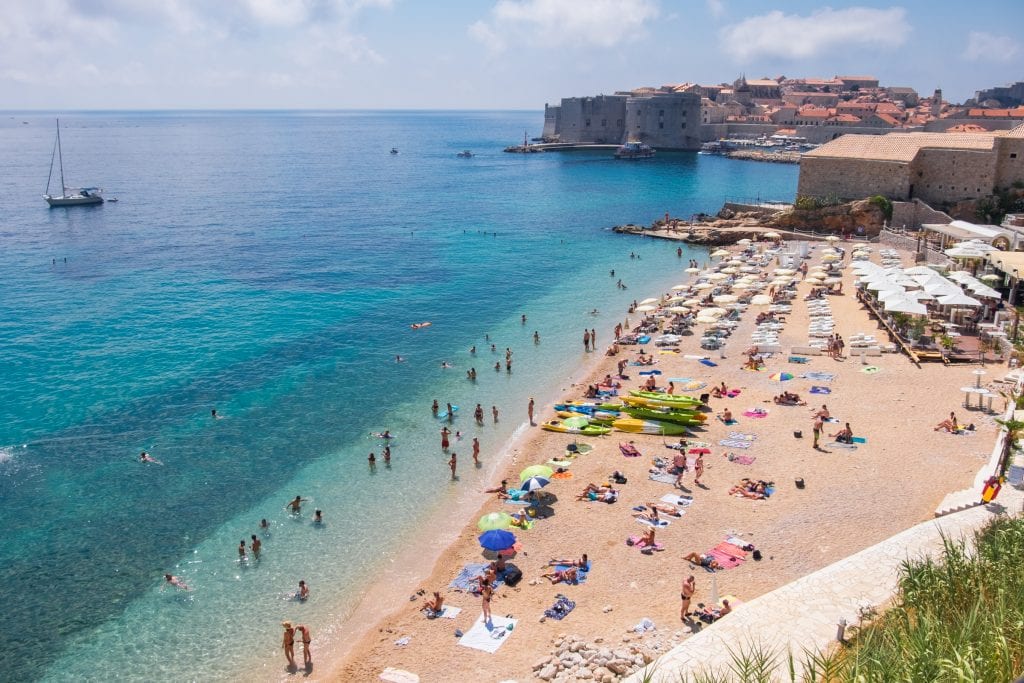
Summer in Croatia
Summer in Croatia is a sizzling time of year. This is when the Adriatic Coast comes to life! Summer is what most travelers have in mind when they visit Croatia, and summer is when Croatia receives most of its tourists from abroad.
Summer is a wonderful time to visit the Dalmatian Coast because it’s sunny and hot with very little precipitation. However, there tends to be one mega-thunderstorm once every summer, so know that it could happen during your visit! (I was in Pelješac for the 2020 storm. It rained so hard it felt like the world was ending. But a few hours later it was over!)
Summer is also when cruise ships are at their peak — particularly in late June, July, and August. Dubrovnik’s old city in particular is crammed with cruise ship tourists during the day, and for this reason I recommend avoiding the old city during the heat of summer days and sticking to visiting at dusk and at night.
Summer can also be quite hot in inland parts of Croatia, like Zagreb and the Slavonia region. Summer also brings tourists to the coastal areas of Istria, which don’t have quite as long a season as those in Dalmatia, so tourism is a bit more condensed here.
Summer brings you the Croatia of your dreams — but because it’s so busy, it’s a good idea to plan your trip ahead of time, especially accommodation, which can book out quickly. I find that early June and late September are better times to enjoy the best of Croatia’s summer while avoiding the worst of the crowds.
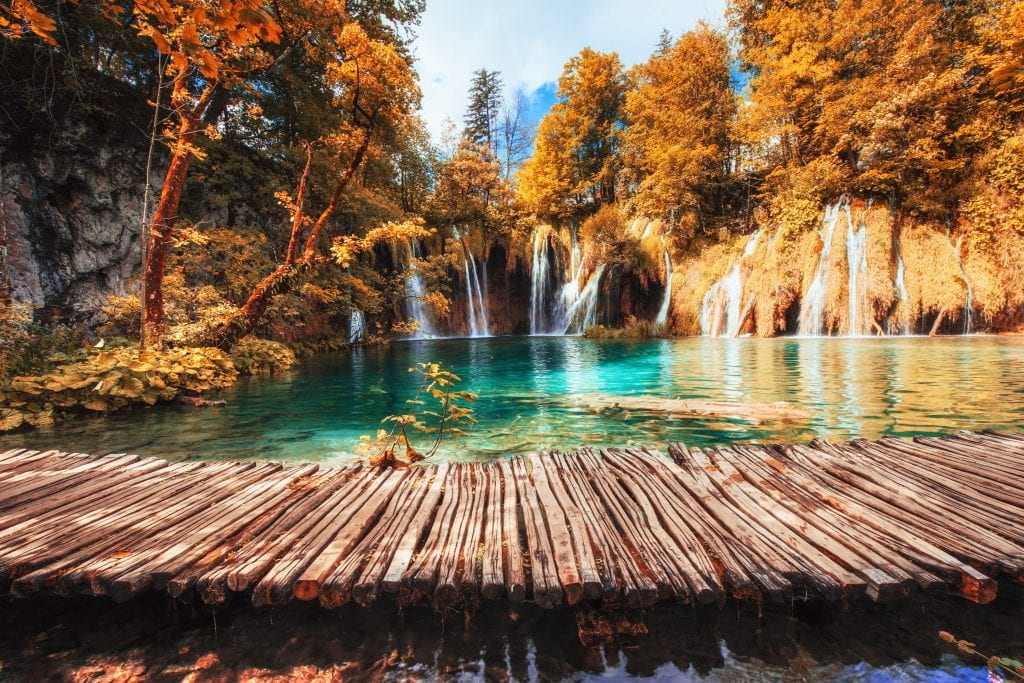
Fall in Croatia
Fall in Croatia — or autumn in Croatia — varies quite a bit based on where you are. In Dubrovnik, you’re enjoying summer weather into October; in Zagreb, Motovun, and Slavonia, October is when things start to get chilly. Either way, it can be a welcome relief from the summer heat and tourist crowds.
When does fall begin in Croatia? Usually in October, as September is still very much the summer months. The further north you go, the earlier the fall begins.
Croatia does get some fall foliage, and this can be a beautiful time to photograph the Plitvice Lakes and other national parks.
Fall is especially a wonderful time to visit Istria, where you can enjoy the bounty of the harvest, truffle hunting, and newly released wines.
Fall can also be a rainy time in Croatia and the rainiest months of the year are November and December. Make sure you bring your umbrella and have a plan for when the sun isn’t shining!
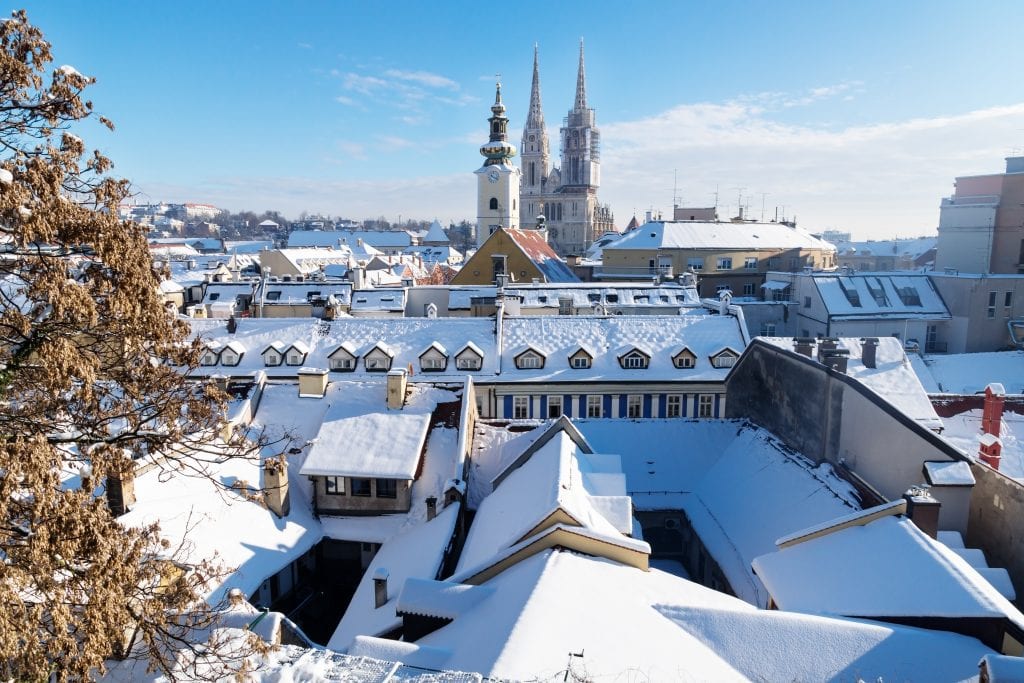
Winter in Croatia
From December through February, Croatia is engulfed in the winter months. In Zagreb, Slavonia, and mountainous parts of Croatia, you can see snow. In warmer parts of the country, like Dalmatia, you’ll have chilly temperatures and rain. It snows in Dubrovnik once in a blue moon.
Is winter a good time to visit Croatia? Generally, I don’t recommend it.
The exception would be if you’re spending time exploring Zagreb, which of course is a year-round city; visiting the Plitvice Lakes to photograph them in the snow; or perhaps spending time in a city like Zadar, which is very quiet but not shut down.
That said, there are a few big winter events in Croatia that deserves mention: Carnival, or Maškare, which takes place mostly in February, and Advent in Zagreb, Zagreb’s Christmas market celebration that lasts the full month of December. Both of these events are well worth your time.
Just understand that visiting Croatia in the winter is a very different experience.
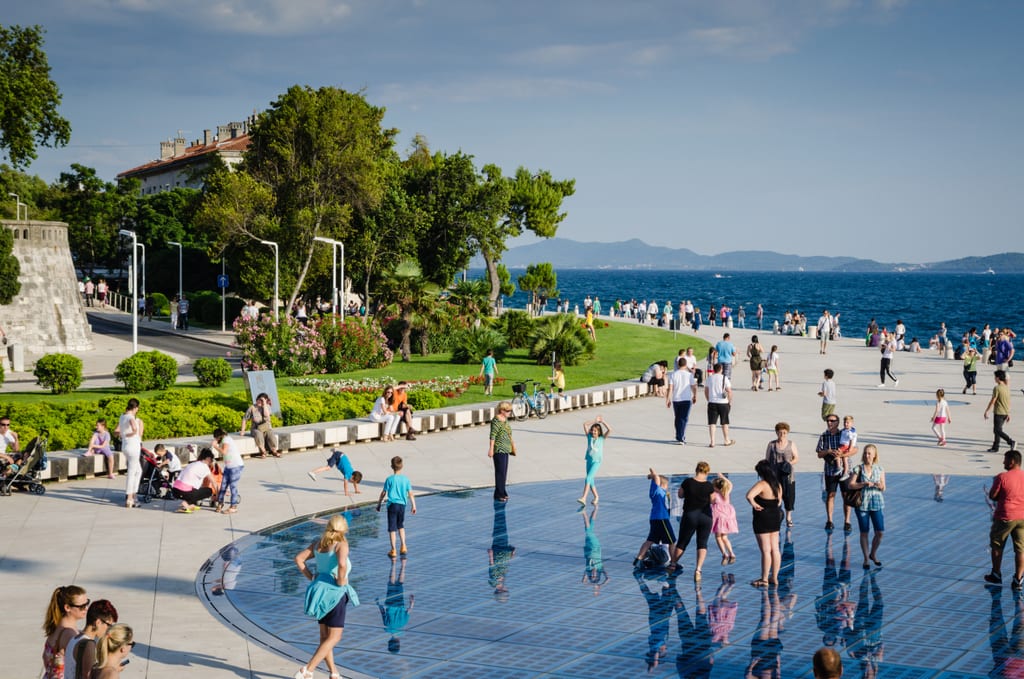
High Season and Low Season in Croatia
High season in Croatia is during the summer months, particularly in Dubrovnik and along the Dalmatian coast, from June through September. This is when prices and temperatures are at their highest and crowds are at their worst.
The absolute peak of high season in Croatia is during the months of July and August, and these months are when most of the cruise ships are docked in ports. While June and September are still technically considered high season, there is a world of difference in crowd levels in places like Split and Dubrovnik.
Shoulder season in Croatia is April to May and late September to October. During this time you have decent prices, few crowds, and zero cruise ships. Most resorts along the Dalmatian coast operate from May through October.
If you’re looking for more of a cultural trip and less of a lie-on-the-beach trip, this can be an excellent time to travel in Croatia. Shoulder season is also my favorite time to travel in Zagreb, Istria, and Slavonia.
Low season in Croatia is during the cold months of the year, from November through March. There are deals to be had during these months, particularly in the larger cities, but much of the Dalmatian coast and more resort-y towns and islands mostly shut down.
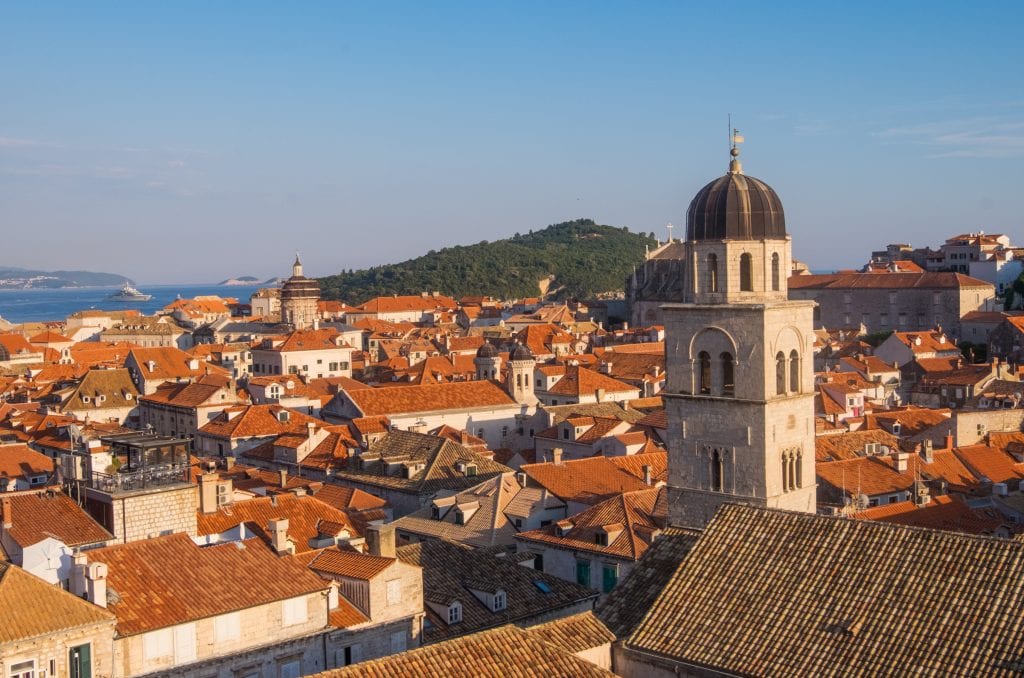
Best Time to Visit Dubrovnik, Zagreb, Rovinj, and More
Croatia may be a small country, but the weather can vary quite a bit. One of my favorite experiences in Croatia is driving from the Zagreb area to Split and the Dalmatian coast, because you drive through mountains under a cloudy sky, go through an enormous tunnel, and when you come out, it’s bright and sunny, like you’ve entered a new country!
That’s how different Dalmatia is — and that’s how different Croatia’s climates can be.
Best Time to Visit Dubrovnik
Dubrovnik is one destination in Croatia where I recommend timing your trip with precision, and the best time to visit Dubrovnik is during September or October. During these months you’ll enjoy warm weather and beach time, and the water will be warm enough for swimming, but you’ll avoid the worst of the cruise ship crowds that arrive in July and August.
Late May and June is another nice time to visit Dubrovnik, but the water won’t be as warm for swimming. If you’re not a swimmer, or you don’t mind cold water, go ahead! You might actually enjoy that more than September.
Dubrovnik Summer Festival takes place during July and August and features concerts, performances, and events in and around the city.
Good Food Festival, either in late September or early October, is a fabulous food celebration in Dubrovnik.
Winter in Dubrovnik is extremely local and very quiet. Locals celebrate the Feast of St. Blaise, Dubrovnik’s patron saint, on February 3 with performances, costumes, and dancing.
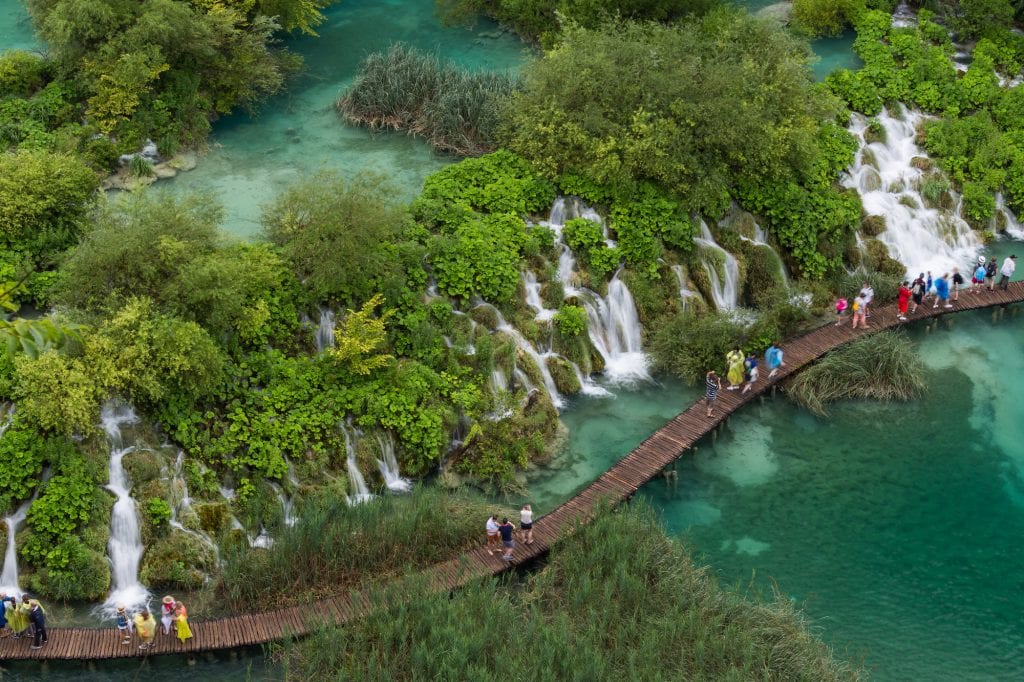
Best Time to Visit Plitvice Lakes
The Plitvice Lakes with their iconic waterfalls are one of the most stunning natural sights in all of Croatia. And because of that, they are a joy to photograph year-round!
In the spring you get extra-flush waterfalls due to snowmelt, plus flowers and budding trees. In the summer you get full, lush greenery. In the fall you get changing colors. And if you time your visit right in the winter, you can experience snow and frozen waterfalls — images that are coveted among many nature photographers.
No matter what time of year you visit, be sure to dress for the weather. The Plitvice Lakes aren’t outfitted with many indoor stations to take a break from the outdoors.
Like the rest of Croatia, July and August are the busiest months at the Plitvice Lakes and host lots of cruise ship shore excursions. It can get very crowded during this time, particularly at the Lower Lakes, so if you’re looking to avoid the worst of the crowds, I would recommend avoiding these two months.
And if you enjoy the Plitvice Lakes, don’t miss Krka National Park!
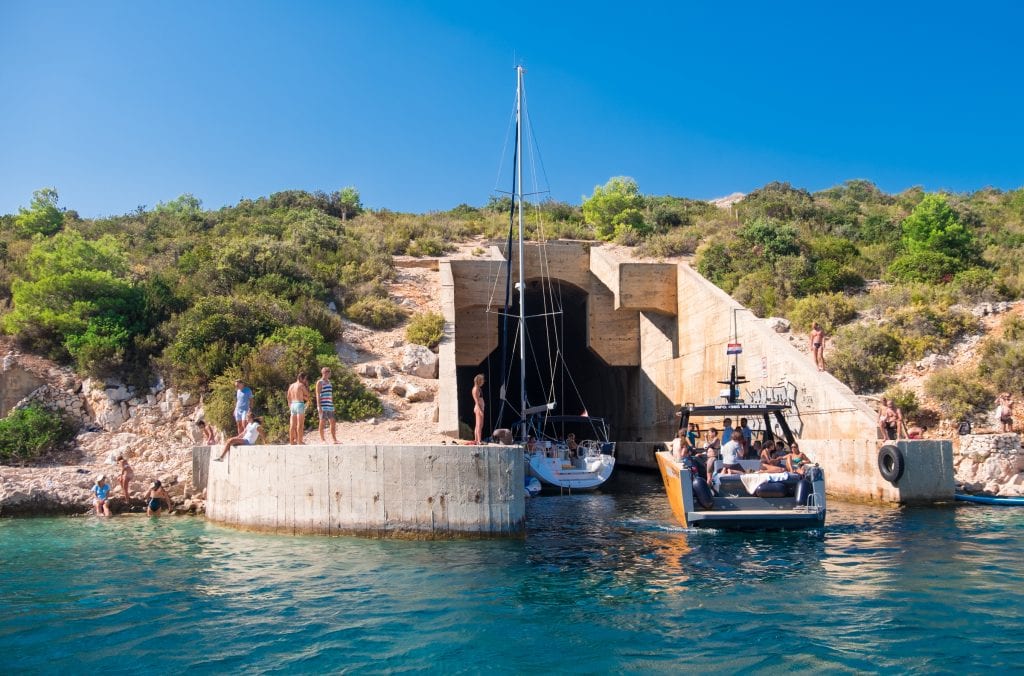
Best Time to Visit the Dalmatian Coast
The Dalmatian coast is blessed with a long and languorous high season. Summer is when this part of Croatia is at its best. You can enjoy summer-like temperatures from late May through early October (though the water is much warmer in September than June).
Whether you’re visiting the relaxing city of Zadar or the endlessly interesting island of Korčula, enjoying the forests and saltwater lakes of Mljet or hiding away in remote Vis, there is plenty to enjoy along the Dalmatian Coast in the summer.
However, I recommend avoiding July and August if possible. This is when tourism is at its peak along the Dalmatian Coast, and some destinations like Dubrovnik are overrun with cruise ship tourists.
My personal favorite month to visit the Dalmatian coast is September.
Shoulder season can be a nice time to visit the Dalmatian coast, but know that some places are going to be closed. I recommend sticking to April, May, and October — months when places are a bit more likely to be open.
In the winter, much of the Dalmatian coast shuts down. Accommodation closes, restaurants close, and ferries run less often. Honestly, I don’t see much of a reason to visit the Dalmatian coast during this time of year.
Split has a lot of festivals. April brings Gast Fair, Croatia’s largest culinary festival. May brings the Feast of St. Dominius, Split’s patron saint, and lots of celebrations leading up to it. Mediterranean Film Festival Split takes place each July. Split Summer Festival is similar to Dubrovnik Summer Festival and brings all kinds of concerts and performances in July and August.
In Ston on the Pelješac peninsula, the Festival of Oysters takes place on March 18, St. Joseph’s Day, and features lots of delicious oysters and wine. The mainland town of Šibenik celebrates Supertoon in July, a festival of animation. See below for more on music festivals.
The island of Korčula celebrates the Sword Dance Festival in June.
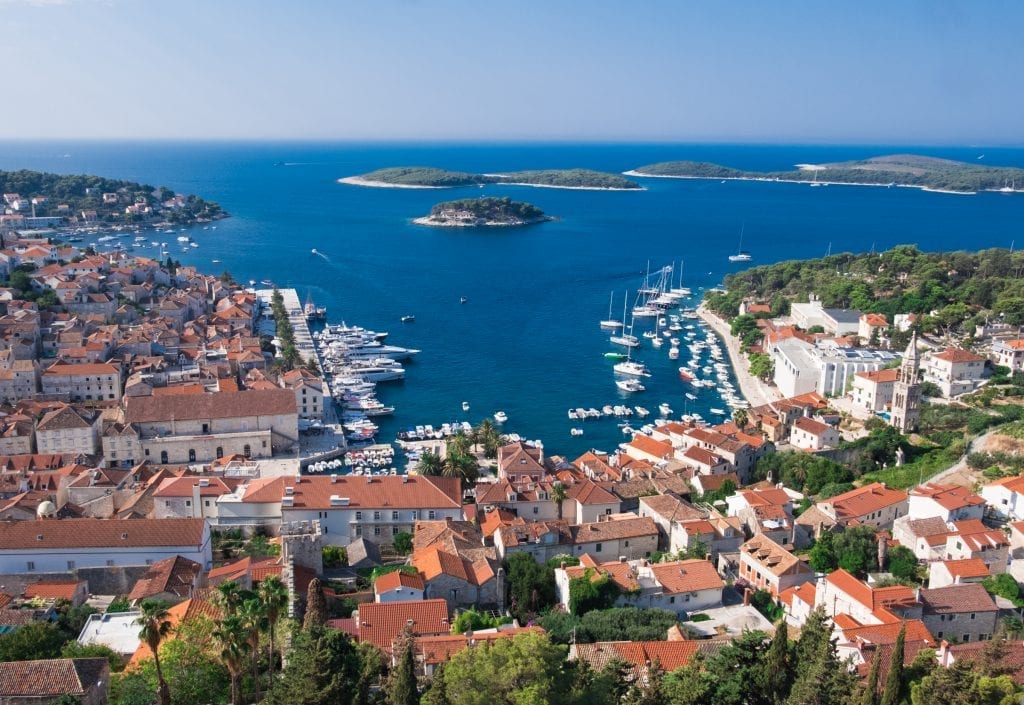
Best Time to Visit Hvar
Being on the Dalmatian Coast, Hvar is blessed with blissful summers — and locals like to say it’s the sunniest island in Europe. Hvar is very much a summer destination, but here summer can extend from late May into early October.
If all you’re looking for is sunshine and warmth, anytime between late May and early October is lovely.
If you’re looking to see Hvar’s famous lavender fields, aim for late June or early July. Lavender has a short season in Hvar.
But if you’re looking to visit Hvar specifically for the party scene, as many travelers do, the season is at its peak in July and August. You’ll pay in terms of crowds and prices, but that’s why you’re here, isn’t it? Being a party person in Hvar comes with a price tag.
In terms of festivals, Hvar celebrates the Feast of St. Prosper, its patron saint, on May 10 with traditional celebrations and a feast. Hvar Summer Festival puts on concerts, events, and performances throughout July and August.
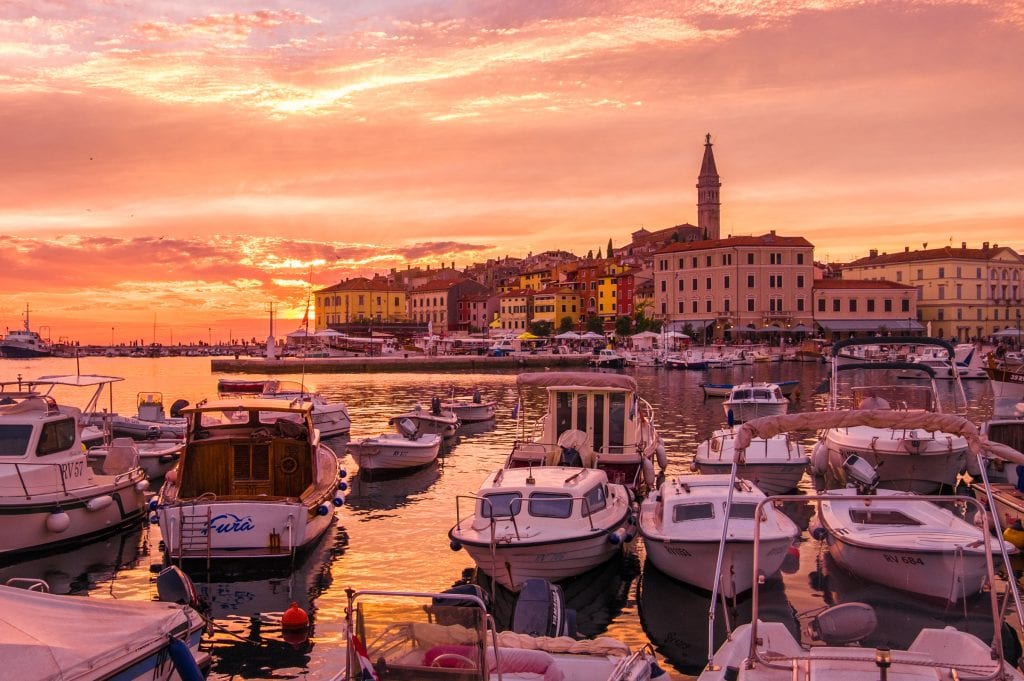
Best Time to Visit Rovinj and Istria
Most people visit Istria in the summer months, and like the Dalmatian coast, summer can be a wonderful time to visit Istria and cities like Rovinj and Motovun. But Istria is not as warm as Dalmatia, nor as sunny as Dalmatia, and the season doesn’t last as long.
If you’re looking to experience summer in Istria, I recommend aiming between mid-June and late September. Know that tourism will be at its peak in July and August.
But shoulder season is another wonderful time to visit Istria — you can visit quiet beach villages and interesting hill towns, all without the high temperatures or peak crowds.
Istria was once part of Italy, feels a lot like Italy, and has many of the same qualities that make Italy great — including a wonderful harvest season. For that reason, visiting Istria during the fall months can be a lot of fun.
Winter in Istria is quiet, particularly in resort towns.
Some festivals to keep in mind for Istria: Rovinj celebrates a three-day Easter Food Festival just before the holiday; the renowned Motovun Film Festival takes places in late July or early August; the Pula Film Festival takes place in July.
The Visualia Festival in Pula takes places in September, with light installations throughout the city; and Zigante Truffle Days in Livade, near Motovun, has events from September through November. Marunada, a celebration of chestnuts, takes place in Lovran, near Opatija, in October.
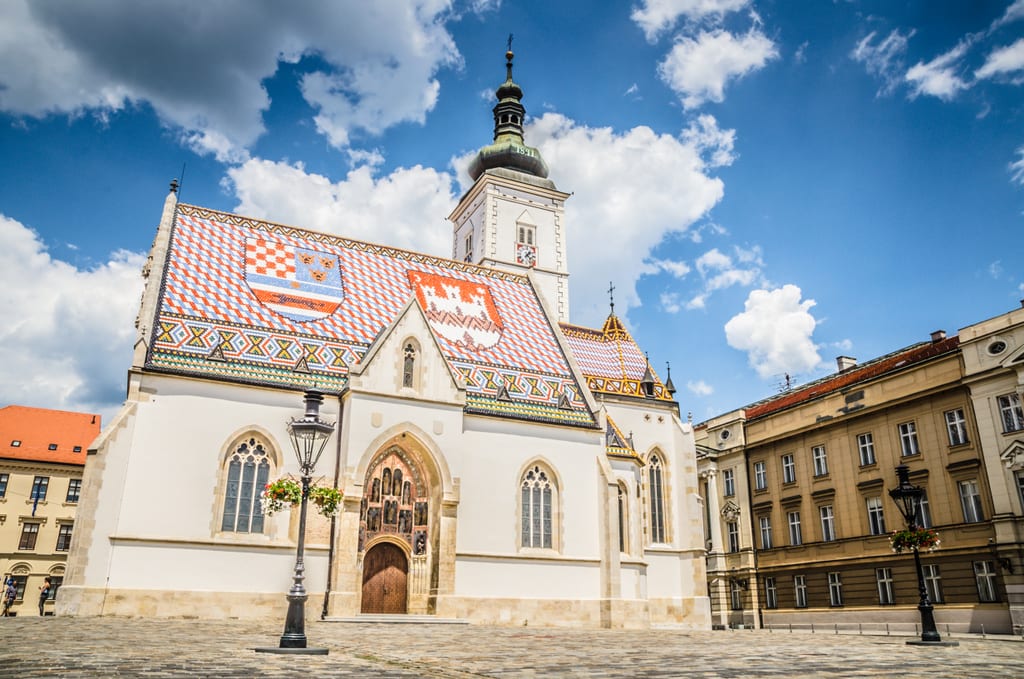
Best Time to Visit Zagreb
Zagreb is Croatia’s largest city, home to 800,000 people. As a result, this city is vibrant year-round. Zagreb has the most tourists in the summer, but it’s nowhere near the level of tourism in Rovinj, Split, or Dubrovnik.
Personally, I think the best time to visit Zagreb is during the shoulder season — April, May, October — to enjoy nice temperatures and city life.
Keep in mind that Zagreb gets much colder than the Dalmatian coast and gets snow in the winter!
March brings the Zagreb Festival of Lights, with light installations over the city. July brings the International Folklore Festival, one of the biggest celebrations of the year.
September brings the International Puppet Festival, with both Croatian and international artists showcasing their craft. Zagreb Film Festival usually takes place in early November.
Perhaps most impressive, though, is Advent in Zagreb — Christmas market season. Zagreb goes all out with decorations, art installations, an ice rink, and food stands featuring traditional Croatian Christmas treats. Unlike Christmas markets in other parts of Europe, this market lasts until January 1 rather than December 23.
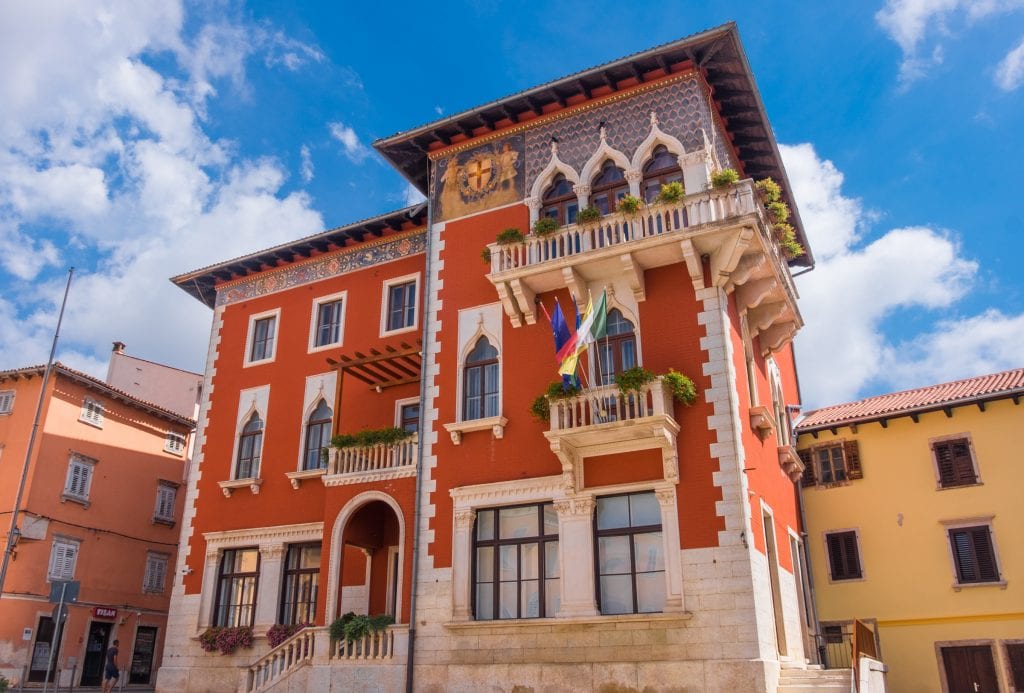
Best Time of Year to Visit Croatia
What is the best month to visit Croatia? Check out the overview here and find out which month is best for you.
January in Croatia
January is when you get the lowest temperatures of the year in Croatia. It will be cold, but there will be few other tourists around, and you’ll have many attractions to yourself — if they’re open, that is.
Some Carnival, or Maškare, celebrations begin in mid-January — particularly in the big Carnival cities like Rijeka.
Temperatures in Zagreb in January average from a low of 28 F / -2 C to a high of 37 F / 3 C.
Temperatures in Dubrovnik in January average from a low of 43 F / 6 C to a high of 54 F / 12 C.
February in Croatia
February is another similar month to January, with low temperatures and few tourists, but that’s okay — this month is when Carnival is at its peak!
Carnival, or Maškare, culminates in February with big celebrations. This is the time for costumed parades and parties. While Rijeka is the undisputed best place to celebrate Maškare, every place in Croatia puts their own spin on it in February.
Dubrovnik marks the Feast of St. Blaise, the city’s patron saint, on February 3 with local events and celebrations.
Temperatures in Zagreb in February average from a low of 32 F / 0 C to a high of 43 F / 6 C.
Temperatures in Dubrovnik in February average from a low of 43 F / 6 C to a high of 55 F / 13 C.
March in Croatia
March is when Croatia starts waking up to spring, with warming temperatures the first appearances of wildflowers. Like many countries, Croatia starts out firmly in winter and emerges into spring.
The Zagreb Festival of Lights takes place in March, with bright light installations representing the arrival of spring and a time of rebirth. In Ston on the Pelješac peninsula, the Festival of Oysters takes place on March 18, St. Joseph’s Day.
Temperatures in Zagreb in March average from a low of 37 F / 3 C to a high of 52 / 11 C.
Temperatures in Dubrovnik in March average from a low of 46 F / 8 C to a high of 57 F / 14 C.
April in Croatia
April is the first official full month of spring. Easter is a major holiday in Croatia and many Croatians take this time to travel domestically. International tourists begin trickling into Croatia in mid-to-late April.
In the days before Easter, Rovinj hosts an Easter Food Festival. Keep in mind that some years this can be in March. Enjoy traditional Istrian Easter dishes, listen to traditional brass bands, and enjoy chocolate eggs! In April, Split hosts Gast Fair, Croatia’s largest culinary festival.
Temperatures in Zagreb in April average from a low of 46 F / 8 C to a high of 61 F / 16 C.
Temperatures in Dubrovnik in April average from a low of 52 F / 11 C to a high of 63 F / 17 C.
May in Croatia
Early May and late May have very different feelings in Croatia. Early May is still firmly in spring with lots of flowers, and by late May, it feels like summer. Tourists are pouring in, hotels have raised their prices, and ferries are running on their summer schedule.
May 7 brings the Festival of St. Dominius, Split’s patron saint, and Split goes all out in celebrations.
Temperatures in Zagreb in May average from a low of 54 F / 12 C to a high of 70 F / 21 C.
Temperatures in Dubrovnik in May average from a low of 57 F / 14 C to a high of 70 F / 21 C.
June in Croatia
Hello, summertime! June is undisputedly the kick-off of summer throughout Croatia. Expect the crowds to swell and temperatures to get fiercely hot.
While you can see Moreška sword dancing throughout the summer in Korčula, June hosts the Sword Dance Festival. Dancers from all over Korčula and other islands come together to compete and perform.
Temperatures in Zagreb in June average from a low of 57 F / 14 C to a high of 75 F / 24 C.
Temperatures in Dubrovnik in June average from a low of 64 F / 18 C to a high of 77 F / 25 C.
July in Croatia
Hot, sweaty, and incredibly crowded. July in Croatia brings long days, lots of sunshine, and the most tourists of the year.
July is festival season in Croatia! Zagreb hosts the International Folklore Festival, featuring traditional music performances all over the city in traditional costume. Šibenik celebrates Supertoon, a festival celebrating animation, in July.
July is a big month for film festivals: Motovun Film Festival, Pula Film Festival, and Mediterranean Film Festival Split all take place in July.
July is also a big month for music festivals: see the music festivals section here.
On the Dalmatian Coast, Dubrovnik Summer Festival, Split Summer Festival, and Hvar Summer Festival bring concerts, events, and performances throughout the month of July.
Temperatures in Zagreb in July average from a low of 61 F / 16 C to a high of 77 F / 25 C.
Temperatures in Dubrovnik in July average from a low of 70 F / 21 C to a high of 84 F / 29 C.
August in Croatia
Yet another month of peak travel in Croatia. August is incredibly hot and one of the most crowded months of the year.
Music festivals continue into August. See the music festivals section here.
On the Dalmatian Coast, Dubrovnik Summer Festival, Split Summer Festival, and Hvar Summer Festival bring concerts, events, and performances throughout the month of August.
Temperatures in Zagreb in August average from a low of 61 F / 16 C to a high of 77 F / 25 C.
Temperatures in Dubrovnik in August average from a low of 70 F / 21 C to a high of 82 F / 28 C.
September in Croatia
Welcome to the sweet spot. September is my personal favorite month fo the year in Croatia, where you can enjoy summer temperatures, warm water, and far fewer tourists than July or August. Early September is still busy (though most families have left), but late September, particularly in Dalmatia, is warm, airy, and divine.
September brings Visualia Festival in the Istrian city of Pula, where light shows take place all over the city and the cranes at the water’s edge light up in bright colors. Zagreb hosts the International Puppet Festival. Zigante Truffle Days in Livade, near Motovun, has events beginning in September.
Temperatures in Zagreb in September average from a low of 55 F / 13 C to a high of 70 F / 21 C.
Temperatures in Dubrovnik in September average from a low of 64 F / 18 C to a high of 77 F / 25 C.
October in Croatia
October can vary quite a bit through Croatia. In Dalmatia, early October feels like an extension of summer, but as you head further north, it’s a time for pleasantly cool temperatures, a bit more rainfall, and the food harvest.
Good Food Festival takes place in Dubrovnik (though occasionally in September). Zigante Truffle Days in Livade, near Motovun, has events throughout October. Marunada, a celebration of chestnuts, takes place in Lovran, near Opatija in Istria, in October.
Temperatures in Zagreb in October average from a low of 46 F / 8 C to a high of 59 F / 15 C.
Temperatures in Dubrovnik in October average from a low of 57 F / 14 C to a high of 70 F / 21 C.
November in Croatia
November is when it cools down throughout the country — and it’s also at its rainiest time of year. You can enjoy some clear days in November, but be prepared for all kinds of weather.
Zagreb Film Festival usually takes place in November. Zigante Truffle Days in Livade, near Motovun, has events concluding in November.
Temperatures in Zagreb in November average from a low of 37 F / 3 C to a high of / 48 C.
Temperatures in Dubrovnik in November average from a low of 50 F / 10 C to a high of 63 F / 17 C.
December in Croatia
Croatia has firmly cooled down by December, and there’s still some rain carryover from November. Zagreb and Slavonia might see the first snow. Christmas celebrations begin throughout the country.
Zagreb explodes with Christmas markets through the month of December for Advent in Zagreb, one of the most underrated city-wide Christmas celebrations in Europe.
Temperatures in Zagreb in December average from a low of 30 F / -1 C to a high of 39 F / 4 C.
Temperatures in Dubrovnik in December average from a low of 46 F / 8 C to a high of 57 F / 14 C.
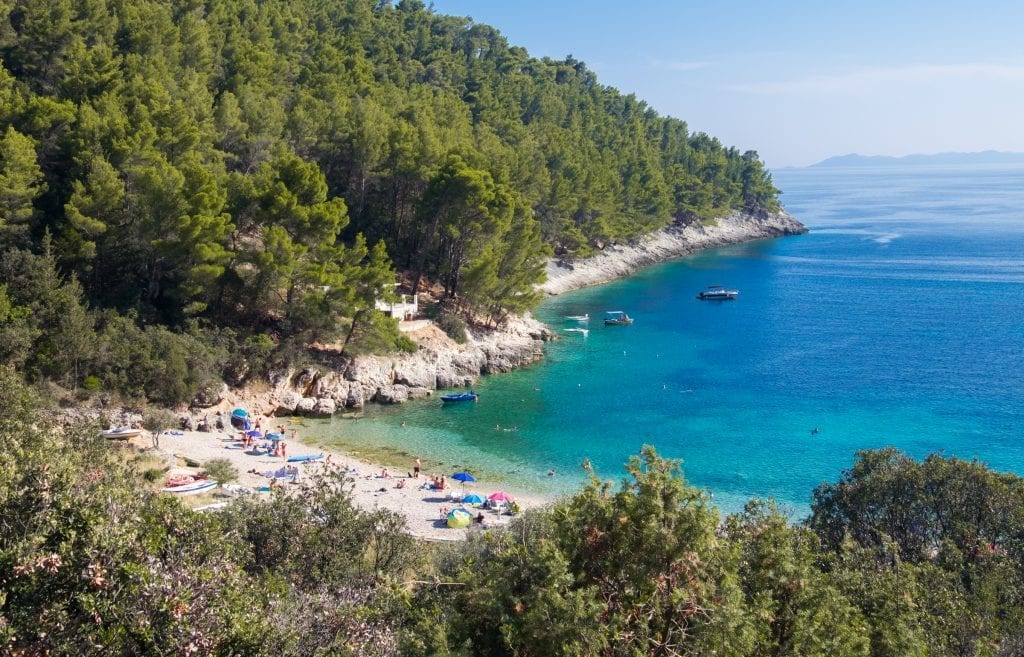
Best Time to Visit Croatia for a Beach Holiday
September would be my first choice for a beach vacation in Croatia. At this time of year you’ve got summer temperatures, yet the crowds are smaller, the cruise ships are gone, and the kids are back in school.
Croatia in September is not exactly a secret, and there will be plenty of travelers there — but it’s nowhere on the level of tourism you see in July and August. For that reason, I recommend aiming toward later in September, when things calm down even more.
Planning a beach holiday in Dalmatia? Aim for late September. Planning a beach holiday in Istria? Plan for early September, as it isn’t quite as warm there.
On the other hand, if you don’t mind water that’s a little bit on the colder side, early June can be another lovely time in Dalmatia. For Istria I’d recommend aiming for late June.
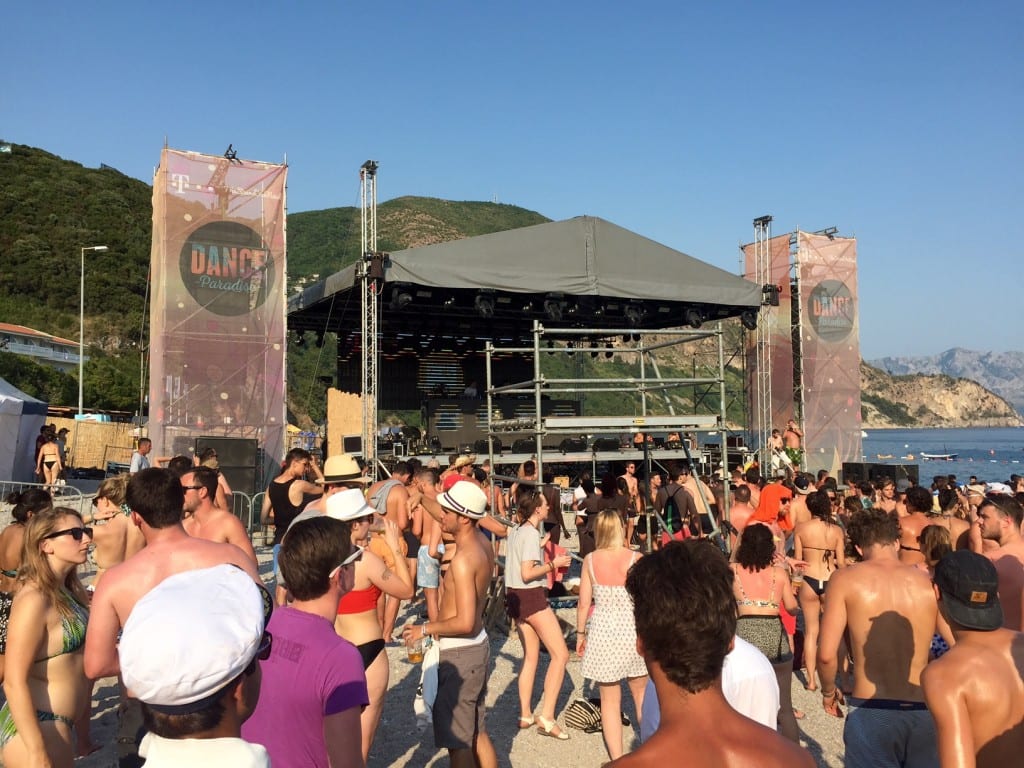
Best Time to Visit Croatia for Music Festivals
Croatia’s coastline explodes with music festivals during the summer months. If you want to hit up a festival or two, the majority of them take place in July and August.
Ultra Europe is the biggest festival with the biggest names in EDM, and it takes place in July in Split.
Umag, a seaside town in Istria, hosts Sea Star Festival in May.
Tisno, on the Dalmatian Coast near Šibenik, hosts Dimensions in July, Hospitality on the Beach in July, SuncéBeat in July, Outlook Origins in July, and Defected Croatia in August.
Zrce Beach on the island of Pag hosts Hideout Festival in June, Fresh Island Week in July and Sonus Festival in August.
INMusic is held in Zagreb in June and draws big names like The Killers.
If you’re hoping to go to music festivals in Croatia and open to a longer trip to the Balkans, consider extending your trip to EXIT in Belgrade, Serbia, and Sea Dance in Budva, Montenegro (the latter of which I quite enjoyed).
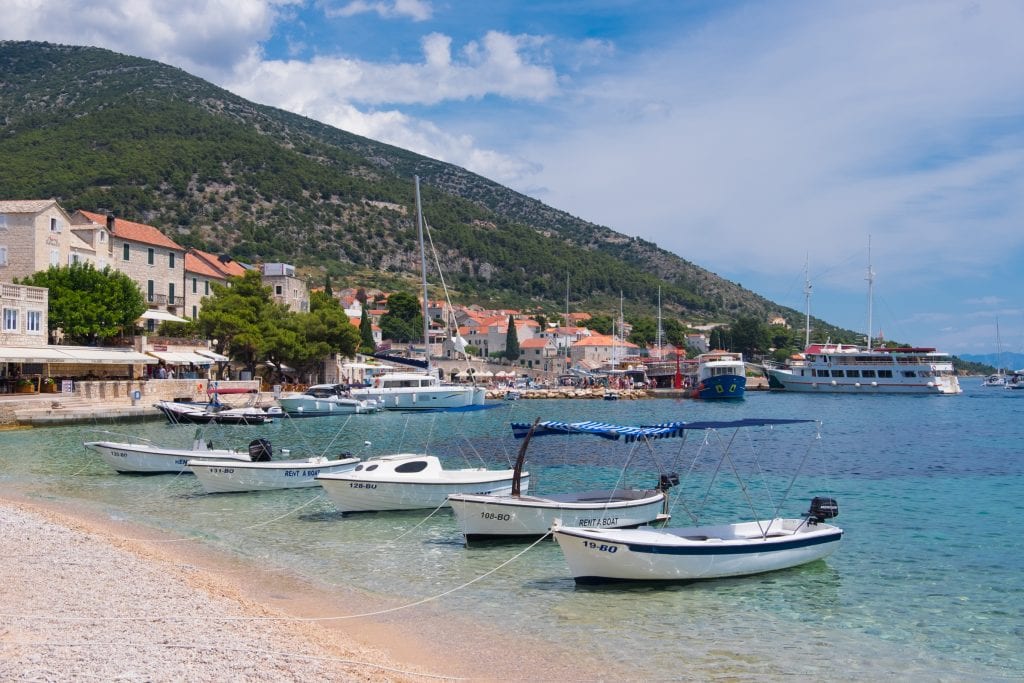
Best Time to Visit Croatia with Kids
Croatia is an extremely family-friendly destination, so don’t worry about bringing your kids to Croatia! Croatians love children and the country is set up to welcome families with kids of all ages.
Most families traveling to Croatia with kids are looking for beach time. If that’s the case for you, aim during their summer vacation. It will be crowded, but it will be easy.
You may be tempted to plan a trip in May or early June, but keep in mind that the Adriatic can be cold during these months. It spends the whole summer warming up. If your kids don’t like swimming in cold water, they probably won’t be a fan of the Adriatic in late spring.
If you’re not visiting for a beach trip, consider visiting during the spring or fall months. You’ll still have nice weather and you won’t have the complete shutdown of winter.
Finally, if you’re up for visiting in February, Carnival can be a LOT of fun for kids — especially if you hit up one of the big festivals like Rijeka.
Bonus tip: of all the places I visited in Croatia, I think the island of Brač is a great choice if you have young kids. It’s the easiest to get to (a short ferry ride from Split, the biggest air hub), and the area around Bol seems designed for families with lots of beaches, a boardwalk, and kid-friendly amenities.
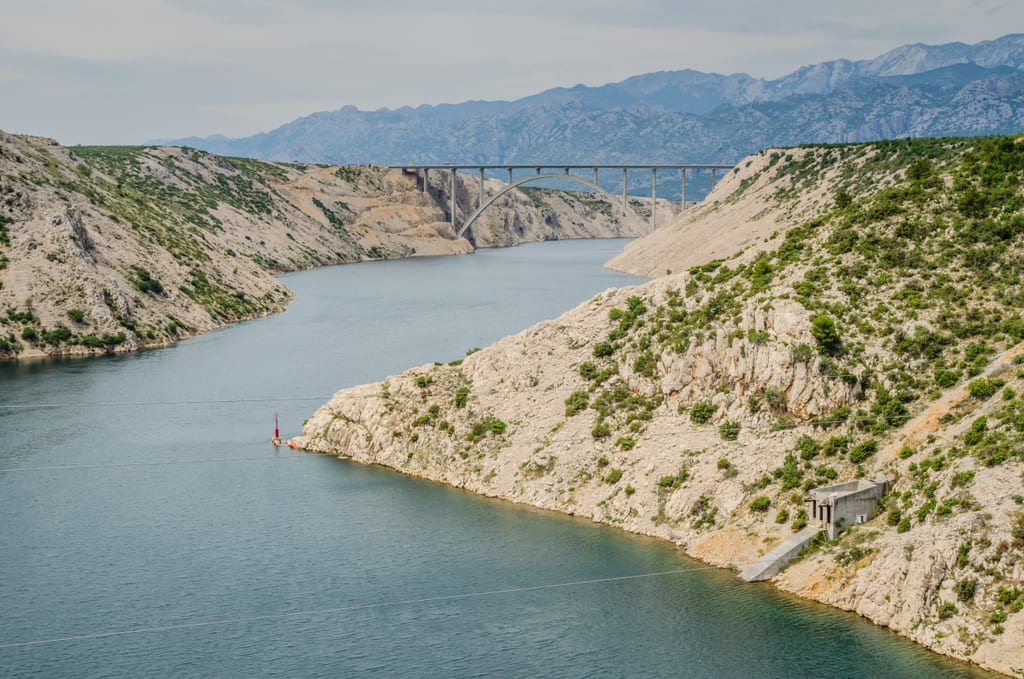
Cheapest Time to Visit Croatia
The cheapest time to visit Croatia is during the winter. This is when accommodation is at its cheapest; if you’re flying to Croatia from North America, you’ll likely find cheaper transatlantic flights.
However, keep in mind that winter in Croatia is cheap for a reason.
Much of Croatia is shut down during the winter months, from restaurants to shops to hotels. Places like the Makarska Riviera almost feel like ghost towns. Many seasonal flights in Croatia don’t run at all in winter; you may need to fly to Zagreb and drive or take public transportation from there.
It’s especially tough traveling the islands in the winter. The island population dwindles down to just the year-round locals, most of whom will wonder why you’re even there, and all the tourist-driven restaurants that the locals avoid won’t be in business.
If you’re looking to experience Croatia at a more active time of year that isn’t the heat of summer, consider April or October — not winter.
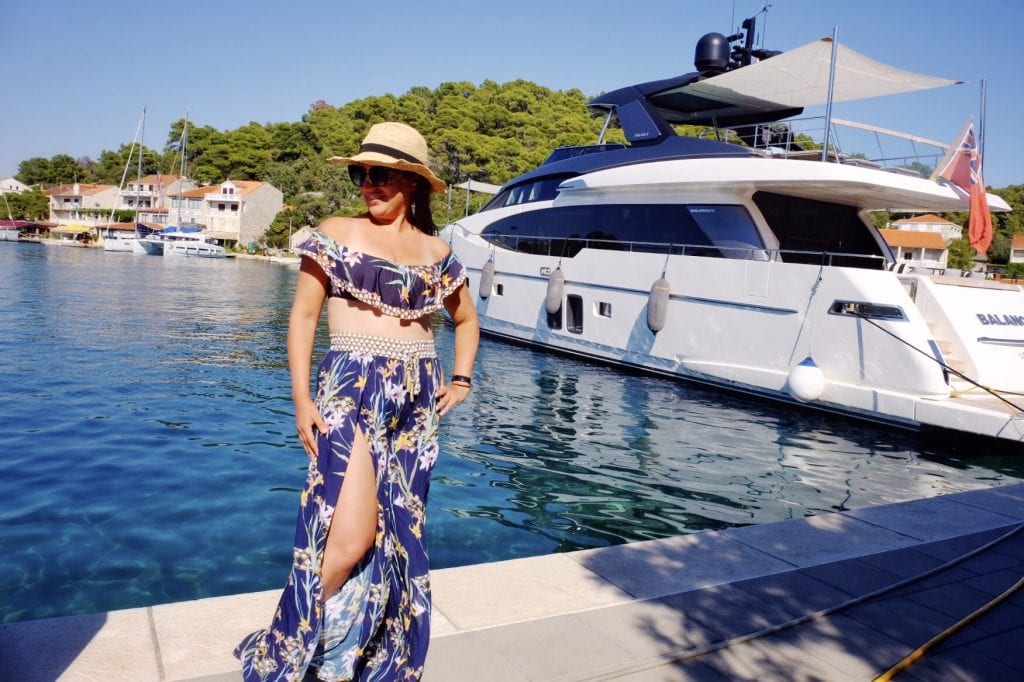
Best Time to Visit Croatia Overall
If you’ve read this far, you know what I think — the best month for visiting Croatia is September, and if you can, aim for mid-to-late September. That is the best time of year to enjoy the best of Croatia’s weather (as well as the Adriatic at its warmest temperature) while avoiding the worst crowds.
September may be golden — but there are so many wonderful times to visit Croatia. You can’t beat Zagreb in December, all decked out for Advent, or Rijeka in February, filled with costume parades, or Split in April, exploding with food festivals.
I hope you enjoy your time in Croatia, no matter what time of year you choose to visit. Then come back and tell me all about it!
Planning a Trip to Croatia:
- Two Weeks in Croatia Itinerary
- What NOT to Do in Croatia
- Solo Female Travel in Croatia: Is it Safe?
- 30 Stunning Mediterranean Islands To Visit In Your Lifetime
Croatian Islands and the Dalmatian Coast:
- How to Spend Three Days in Dubrovnik
- Why Korčula, Croatia, is the Coolest Island of All
- Vis, Croatia, is a Quietly Stunning Island
- Dubrovnik Survival Guide
- The Waterfalls of Krka National Park
- A Place Like Zadar
- 30 Fabulous Things To Do in Split, Croatia
- 29 Sunny Things To Do In Hvar, Croatia
Istria and the North:
- Guide to Rovinj, Croatia’s Prettiest City
- Places to Visit in Istria, Croatia’s Italian-Flavored Peninsula
- 21 Unforgettable Things To Do In Zagreb, Croatia
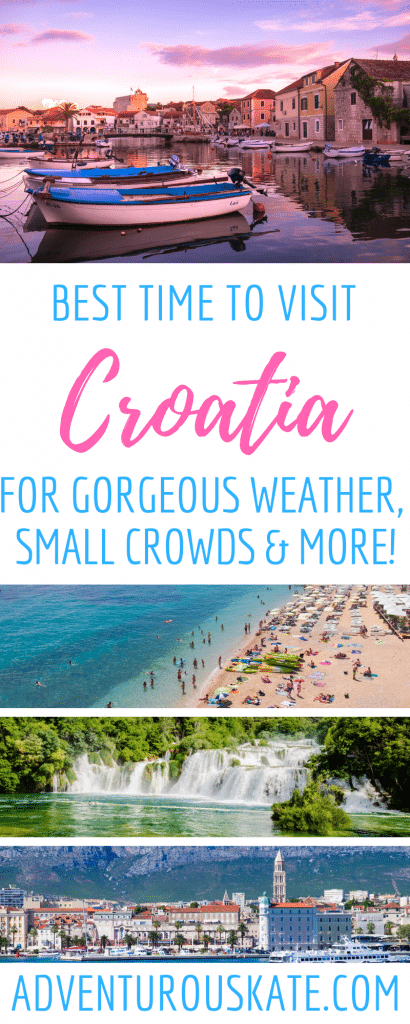
Have you been to Croatia? What time of year did you visit? Share away!